Performance, Liquidity, and Financial Structure Analysis of Tesco PLC
VerifiedAdded on 2023/06/18
|7
|1807
|447
Report
AI Summary
This report provides a comprehensive financial analysis of Tesco PLC from 2017 to 2020, evaluating its performance, liquidity, and financial structure. It examines various financial ratios, including return on capital employed, gross profit ratio, and inventory turnover ratio, to assess the company's profitability and efficiency. The analysis highlights both improvements and areas needing attention, such as the decline in return on capital employed in 2020. The report also discusses the limitations of using accounting ratios and concludes that while Tesco's financial performance has improved, further adjustments are needed to achieve global leadership. The findings suggest that Tesco PLC should focus on addressing deficiencies in various functions and maximizing shareholder value to enhance its position in the market.
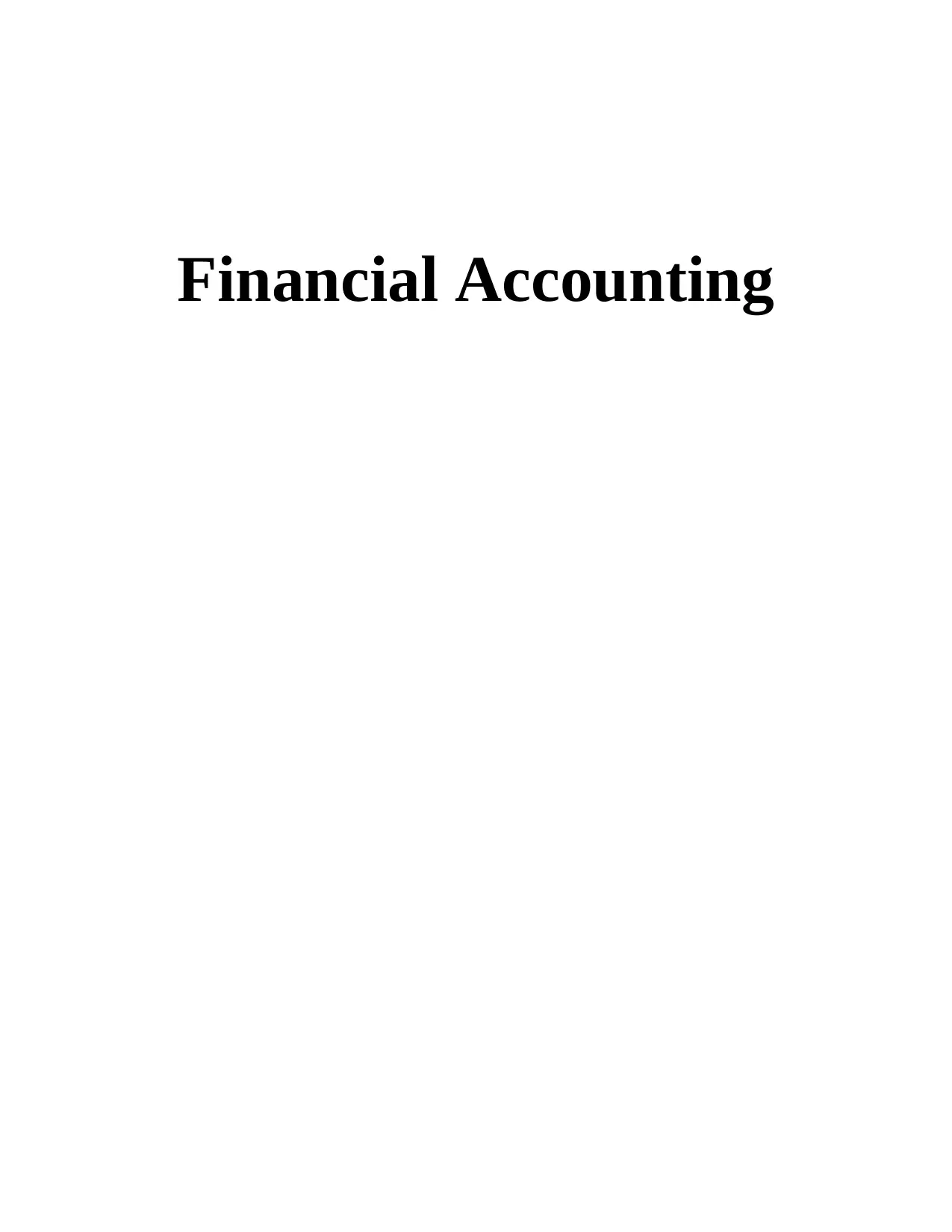
Financial Accounting
Paraphrase This Document
Need a fresh take? Get an instant paraphrase of this document with our AI Paraphraser

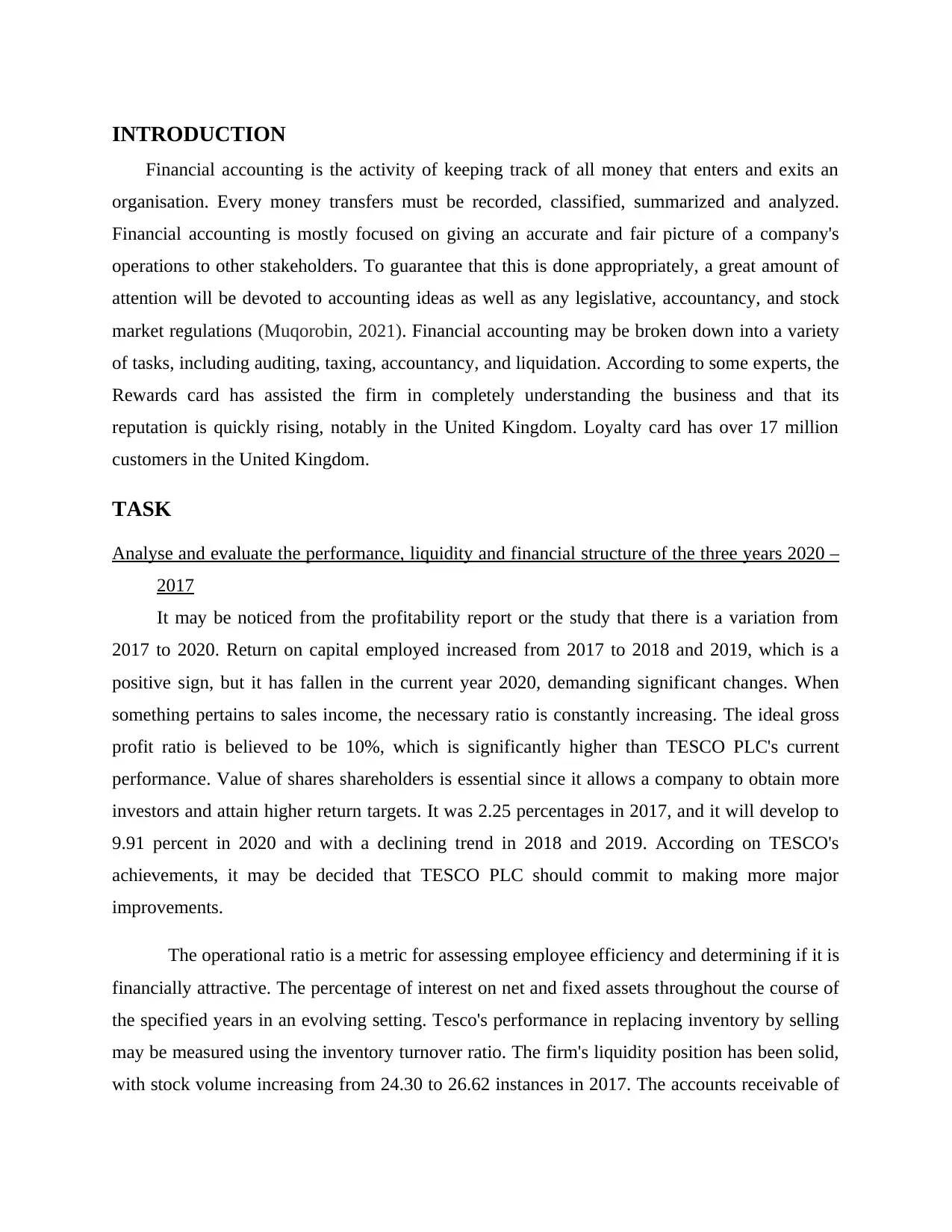
INTRODUCTION
Financial accounting is the activity of keeping track of all money that enters and exits an
organisation. Every money transfers must be recorded, classified, summarized and analyzed.
Financial accounting is mostly focused on giving an accurate and fair picture of a company's
operations to other stakeholders. To guarantee that this is done appropriately, a great amount of
attention will be devoted to accounting ideas as well as any legislative, accountancy, and stock
market regulations (Muqorobin, 2021). Financial accounting may be broken down into a variety
of tasks, including auditing, taxing, accountancy, and liquidation. According to some experts, the
Rewards card has assisted the firm in completely understanding the business and that its
reputation is quickly rising, notably in the United Kingdom. Loyalty card has over 17 million
customers in the United Kingdom.
TASK
Analyse and evaluate the performance, liquidity and financial structure of the three years 2020 –
2017
It may be noticed from the profitability report or the study that there is a variation from
2017 to 2020. Return on capital employed increased from 2017 to 2018 and 2019, which is a
positive sign, but it has fallen in the current year 2020, demanding significant changes. When
something pertains to sales income, the necessary ratio is constantly increasing. The ideal gross
profit ratio is believed to be 10%, which is significantly higher than TESCO PLC's current
performance. Value of shares shareholders is essential since it allows a company to obtain more
investors and attain higher return targets. It was 2.25 percentages in 2017, and it will develop to
9.91 percent in 2020 and with a declining trend in 2018 and 2019. According on TESCO's
achievements, it may be decided that TESCO PLC should commit to making more major
improvements.
The operational ratio is a metric for assessing employee efficiency and determining if it is
financially attractive. The percentage of interest on net and fixed assets throughout the course of
the specified years in an evolving setting. Tesco's performance in replacing inventory by selling
may be measured using the inventory turnover ratio. The firm's liquidity position has been solid,
with stock volume increasing from 24.30 to 26.62 instances in 2017. The accounts receivable of
Financial accounting is the activity of keeping track of all money that enters and exits an
organisation. Every money transfers must be recorded, classified, summarized and analyzed.
Financial accounting is mostly focused on giving an accurate and fair picture of a company's
operations to other stakeholders. To guarantee that this is done appropriately, a great amount of
attention will be devoted to accounting ideas as well as any legislative, accountancy, and stock
market regulations (Muqorobin, 2021). Financial accounting may be broken down into a variety
of tasks, including auditing, taxing, accountancy, and liquidation. According to some experts, the
Rewards card has assisted the firm in completely understanding the business and that its
reputation is quickly rising, notably in the United Kingdom. Loyalty card has over 17 million
customers in the United Kingdom.
TASK
Analyse and evaluate the performance, liquidity and financial structure of the three years 2020 –
2017
It may be noticed from the profitability report or the study that there is a variation from
2017 to 2020. Return on capital employed increased from 2017 to 2018 and 2019, which is a
positive sign, but it has fallen in the current year 2020, demanding significant changes. When
something pertains to sales income, the necessary ratio is constantly increasing. The ideal gross
profit ratio is believed to be 10%, which is significantly higher than TESCO PLC's current
performance. Value of shares shareholders is essential since it allows a company to obtain more
investors and attain higher return targets. It was 2.25 percentages in 2017, and it will develop to
9.91 percent in 2020 and with a declining trend in 2018 and 2019. According on TESCO's
achievements, it may be decided that TESCO PLC should commit to making more major
improvements.
The operational ratio is a metric for assessing employee efficiency and determining if it is
financially attractive. The percentage of interest on net and fixed assets throughout the course of
the specified years in an evolving setting. Tesco's performance in replacing inventory by selling
may be measured using the inventory turnover ratio. The firm's liquidity position has been solid,
with stock volume increasing from 24.30 to 26.62 instances in 2017. The accounts receivable of
⊘ This is a preview!⊘
Do you want full access?
Subscribe today to unlock all pages.

Trusted by 1+ million students worldwide
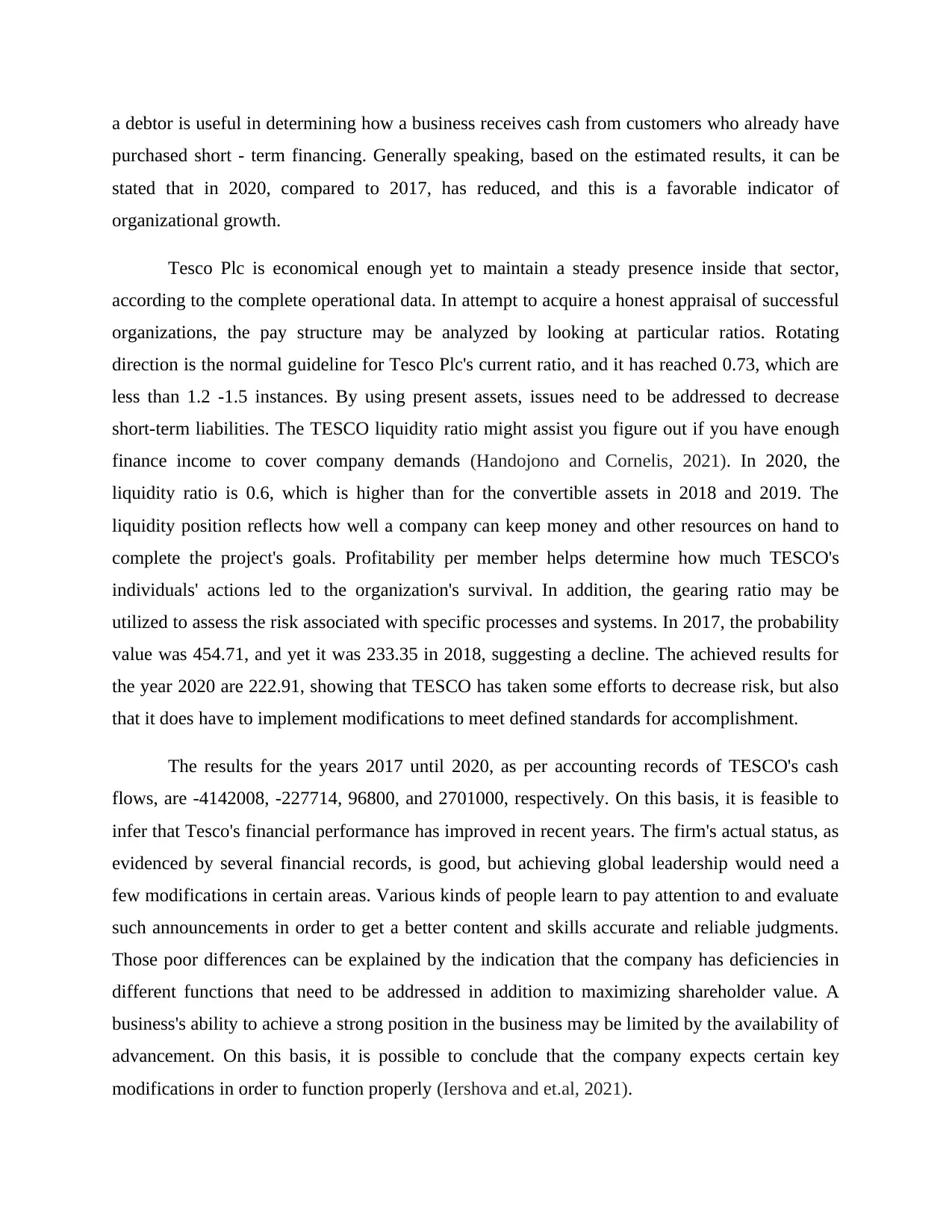
a debtor is useful in determining how a business receives cash from customers who already have
purchased short - term financing. Generally speaking, based on the estimated results, it can be
stated that in 2020, compared to 2017, has reduced, and this is a favorable indicator of
organizational growth.
Tesco Plc is economical enough yet to maintain a steady presence inside that sector,
according to the complete operational data. In attempt to acquire a honest appraisal of successful
organizations, the pay structure may be analyzed by looking at particular ratios. Rotating
direction is the normal guideline for Tesco Plc's current ratio, and it has reached 0.73, which are
less than 1.2 -1.5 instances. By using present assets, issues need to be addressed to decrease
short-term liabilities. The TESCO liquidity ratio might assist you figure out if you have enough
finance income to cover company demands (Handojono and Cornelis, 2021). In 2020, the
liquidity ratio is 0.6, which is higher than for the convertible assets in 2018 and 2019. The
liquidity position reflects how well a company can keep money and other resources on hand to
complete the project's goals. Profitability per member helps determine how much TESCO's
individuals' actions led to the organization's survival. In addition, the gearing ratio may be
utilized to assess the risk associated with specific processes and systems. In 2017, the probability
value was 454.71, and yet it was 233.35 in 2018, suggesting a decline. The achieved results for
the year 2020 are 222.91, showing that TESCO has taken some efforts to decrease risk, but also
that it does have to implement modifications to meet defined standards for accomplishment.
The results for the years 2017 until 2020, as per accounting records of TESCO's cash
flows, are -4142008, -227714, 96800, and 2701000, respectively. On this basis, it is feasible to
infer that Tesco's financial performance has improved in recent years. The firm's actual status, as
evidenced by several financial records, is good, but achieving global leadership would need a
few modifications in certain areas. Various kinds of people learn to pay attention to and evaluate
such announcements in order to get a better content and skills accurate and reliable judgments.
Those poor differences can be explained by the indication that the company has deficiencies in
different functions that need to be addressed in addition to maximizing shareholder value. A
business's ability to achieve a strong position in the business may be limited by the availability of
advancement. On this basis, it is possible to conclude that the company expects certain key
modifications in order to function properly (Iershova and et.al, 2021).
purchased short - term financing. Generally speaking, based on the estimated results, it can be
stated that in 2020, compared to 2017, has reduced, and this is a favorable indicator of
organizational growth.
Tesco Plc is economical enough yet to maintain a steady presence inside that sector,
according to the complete operational data. In attempt to acquire a honest appraisal of successful
organizations, the pay structure may be analyzed by looking at particular ratios. Rotating
direction is the normal guideline for Tesco Plc's current ratio, and it has reached 0.73, which are
less than 1.2 -1.5 instances. By using present assets, issues need to be addressed to decrease
short-term liabilities. The TESCO liquidity ratio might assist you figure out if you have enough
finance income to cover company demands (Handojono and Cornelis, 2021). In 2020, the
liquidity ratio is 0.6, which is higher than for the convertible assets in 2018 and 2019. The
liquidity position reflects how well a company can keep money and other resources on hand to
complete the project's goals. Profitability per member helps determine how much TESCO's
individuals' actions led to the organization's survival. In addition, the gearing ratio may be
utilized to assess the risk associated with specific processes and systems. In 2017, the probability
value was 454.71, and yet it was 233.35 in 2018, suggesting a decline. The achieved results for
the year 2020 are 222.91, showing that TESCO has taken some efforts to decrease risk, but also
that it does have to implement modifications to meet defined standards for accomplishment.
The results for the years 2017 until 2020, as per accounting records of TESCO's cash
flows, are -4142008, -227714, 96800, and 2701000, respectively. On this basis, it is feasible to
infer that Tesco's financial performance has improved in recent years. The firm's actual status, as
evidenced by several financial records, is good, but achieving global leadership would need a
few modifications in certain areas. Various kinds of people learn to pay attention to and evaluate
such announcements in order to get a better content and skills accurate and reliable judgments.
Those poor differences can be explained by the indication that the company has deficiencies in
different functions that need to be addressed in addition to maximizing shareholder value. A
business's ability to achieve a strong position in the business may be limited by the availability of
advancement. On this basis, it is possible to conclude that the company expects certain key
modifications in order to function properly (Iershova and et.al, 2021).
Paraphrase This Document
Need a fresh take? Get an instant paraphrase of this document with our AI Paraphraser
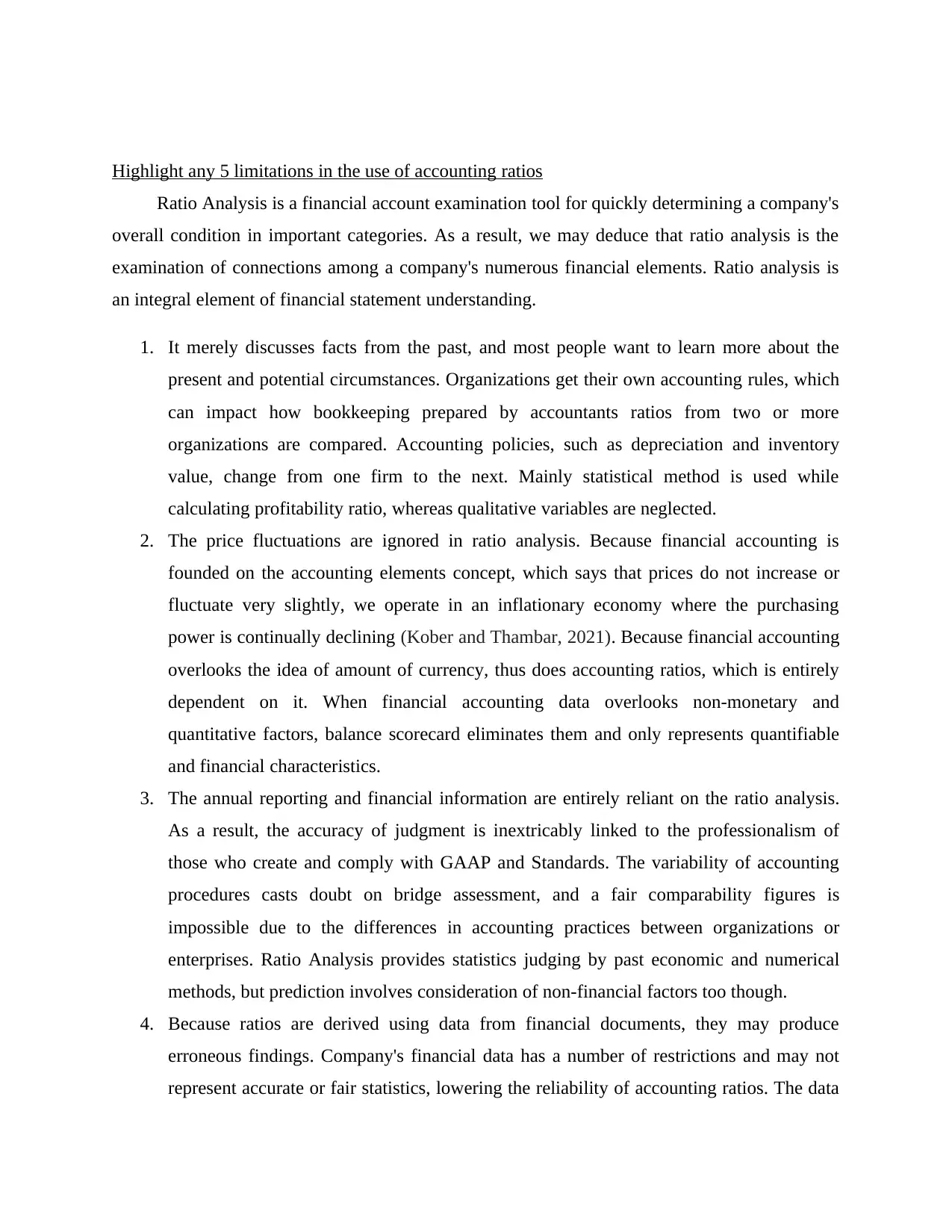
Highlight any 5 limitations in the use of accounting ratios
Ratio Analysis is a financial account examination tool for quickly determining a company's
overall condition in important categories. As a result, we may deduce that ratio analysis is the
examination of connections among a company's numerous financial elements. Ratio analysis is
an integral element of financial statement understanding.
1. It merely discusses facts from the past, and most people want to learn more about the
present and potential circumstances. Organizations get their own accounting rules, which
can impact how bookkeeping prepared by accountants ratios from two or more
organizations are compared. Accounting policies, such as depreciation and inventory
value, change from one firm to the next. Mainly statistical method is used while
calculating profitability ratio, whereas qualitative variables are neglected.
2. The price fluctuations are ignored in ratio analysis. Because financial accounting is
founded on the accounting elements concept, which says that prices do not increase or
fluctuate very slightly, we operate in an inflationary economy where the purchasing
power is continually declining (Kober and Thambar, 2021). Because financial accounting
overlooks the idea of amount of currency, thus does accounting ratios, which is entirely
dependent on it. When financial accounting data overlooks non-monetary and
quantitative factors, balance scorecard eliminates them and only represents quantifiable
and financial characteristics.
3. The annual reporting and financial information are entirely reliant on the ratio analysis.
As a result, the accuracy of judgment is inextricably linked to the professionalism of
those who create and comply with GAAP and Standards. The variability of accounting
procedures casts doubt on bridge assessment, and a fair comparability figures is
impossible due to the differences in accounting practices between organizations or
enterprises. Ratio Analysis provides statistics judging by past economic and numerical
methods, but prediction involves consideration of non-financial factors too though.
4. Because ratios are derived using data from financial documents, they may produce
erroneous findings. Company's financial data has a number of restrictions and may not
represent accurate or fair statistics, lowering the reliability of accounting ratios. The data
Ratio Analysis is a financial account examination tool for quickly determining a company's
overall condition in important categories. As a result, we may deduce that ratio analysis is the
examination of connections among a company's numerous financial elements. Ratio analysis is
an integral element of financial statement understanding.
1. It merely discusses facts from the past, and most people want to learn more about the
present and potential circumstances. Organizations get their own accounting rules, which
can impact how bookkeeping prepared by accountants ratios from two or more
organizations are compared. Accounting policies, such as depreciation and inventory
value, change from one firm to the next. Mainly statistical method is used while
calculating profitability ratio, whereas qualitative variables are neglected.
2. The price fluctuations are ignored in ratio analysis. Because financial accounting is
founded on the accounting elements concept, which says that prices do not increase or
fluctuate very slightly, we operate in an inflationary economy where the purchasing
power is continually declining (Kober and Thambar, 2021). Because financial accounting
overlooks the idea of amount of currency, thus does accounting ratios, which is entirely
dependent on it. When financial accounting data overlooks non-monetary and
quantitative factors, balance scorecard eliminates them and only represents quantifiable
and financial characteristics.
3. The annual reporting and financial information are entirely reliant on the ratio analysis.
As a result, the accuracy of judgment is inextricably linked to the professionalism of
those who create and comply with GAAP and Standards. The variability of accounting
procedures casts doubt on bridge assessment, and a fair comparability figures is
impossible due to the differences in accounting practices between organizations or
enterprises. Ratio Analysis provides statistics judging by past economic and numerical
methods, but prediction involves consideration of non-financial factors too though.
4. Because ratios are derived using data from financial documents, they may produce
erroneous findings. Company's financial data has a number of restrictions and may not
represent accurate or fair statistics, lowering the reliability of accounting ratios. The data
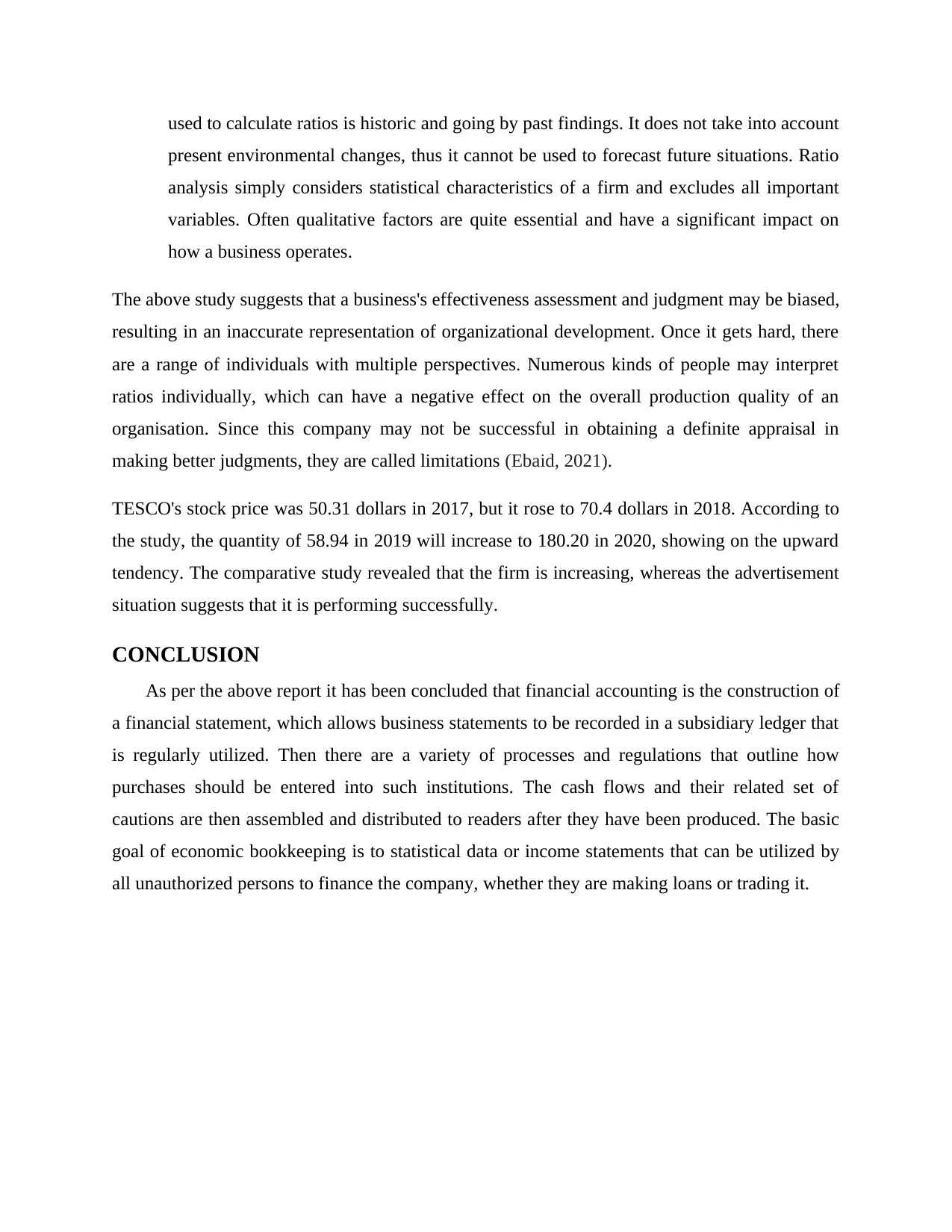
used to calculate ratios is historic and going by past findings. It does not take into account
present environmental changes, thus it cannot be used to forecast future situations. Ratio
analysis simply considers statistical characteristics of a firm and excludes all important
variables. Often qualitative factors are quite essential and have a significant impact on
how a business operates.
The above study suggests that a business's effectiveness assessment and judgment may be biased,
resulting in an inaccurate representation of organizational development. Once it gets hard, there
are a range of individuals with multiple perspectives. Numerous kinds of people may interpret
ratios individually, which can have a negative effect on the overall production quality of an
organisation. Since this company may not be successful in obtaining a definite appraisal in
making better judgments, they are called limitations (Ebaid, 2021).
TESCO's stock price was 50.31 dollars in 2017, but it rose to 70.4 dollars in 2018. According to
the study, the quantity of 58.94 in 2019 will increase to 180.20 in 2020, showing on the upward
tendency. The comparative study revealed that the firm is increasing, whereas the advertisement
situation suggests that it is performing successfully.
CONCLUSION
As per the above report it has been concluded that financial accounting is the construction of
a financial statement, which allows business statements to be recorded in a subsidiary ledger that
is regularly utilized. Then there are a variety of processes and regulations that outline how
purchases should be entered into such institutions. The cash flows and their related set of
cautions are then assembled and distributed to readers after they have been produced. The basic
goal of economic bookkeeping is to statistical data or income statements that can be utilized by
all unauthorized persons to finance the company, whether they are making loans or trading it.
present environmental changes, thus it cannot be used to forecast future situations. Ratio
analysis simply considers statistical characteristics of a firm and excludes all important
variables. Often qualitative factors are quite essential and have a significant impact on
how a business operates.
The above study suggests that a business's effectiveness assessment and judgment may be biased,
resulting in an inaccurate representation of organizational development. Once it gets hard, there
are a range of individuals with multiple perspectives. Numerous kinds of people may interpret
ratios individually, which can have a negative effect on the overall production quality of an
organisation. Since this company may not be successful in obtaining a definite appraisal in
making better judgments, they are called limitations (Ebaid, 2021).
TESCO's stock price was 50.31 dollars in 2017, but it rose to 70.4 dollars in 2018. According to
the study, the quantity of 58.94 in 2019 will increase to 180.20 in 2020, showing on the upward
tendency. The comparative study revealed that the firm is increasing, whereas the advertisement
situation suggests that it is performing successfully.
CONCLUSION
As per the above report it has been concluded that financial accounting is the construction of
a financial statement, which allows business statements to be recorded in a subsidiary ledger that
is regularly utilized. Then there are a variety of processes and regulations that outline how
purchases should be entered into such institutions. The cash flows and their related set of
cautions are then assembled and distributed to readers after they have been produced. The basic
goal of economic bookkeeping is to statistical data or income statements that can be utilized by
all unauthorized persons to finance the company, whether they are making loans or trading it.
⊘ This is a preview!⊘
Do you want full access?
Subscribe today to unlock all pages.

Trusted by 1+ million students worldwide
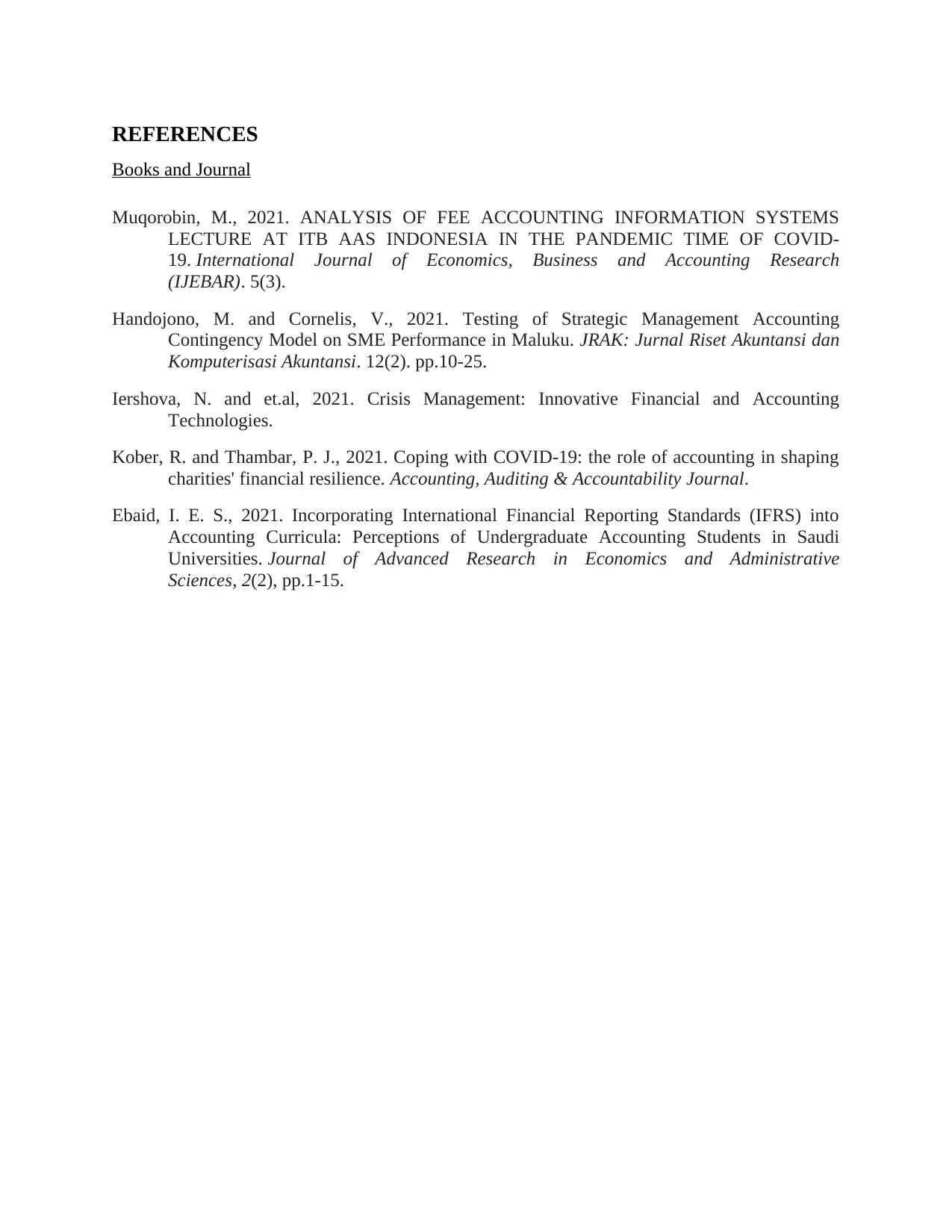
REFERENCES
Books and Journal
Muqorobin, M., 2021. ANALYSIS OF FEE ACCOUNTING INFORMATION SYSTEMS
LECTURE AT ITB AAS INDONESIA IN THE PANDEMIC TIME OF COVID-
19. International Journal of Economics, Business and Accounting Research
(IJEBAR). 5(3).
Handojono, M. and Cornelis, V., 2021. Testing of Strategic Management Accounting
Contingency Model on SME Performance in Maluku. JRAK: Jurnal Riset Akuntansi dan
Komputerisasi Akuntansi. 12(2). pp.10-25.
Iershova, N. and et.al, 2021. Crisis Management: Innovative Financial and Accounting
Technologies.
Kober, R. and Thambar, P. J., 2021. Coping with COVID-19: the role of accounting in shaping
charities' financial resilience. Accounting, Auditing & Accountability Journal.
Ebaid, I. E. S., 2021. Incorporating International Financial Reporting Standards (IFRS) into
Accounting Curricula: Perceptions of Undergraduate Accounting Students in Saudi
Universities. Journal of Advanced Research in Economics and Administrative
Sciences, 2(2), pp.1-15.
Books and Journal
Muqorobin, M., 2021. ANALYSIS OF FEE ACCOUNTING INFORMATION SYSTEMS
LECTURE AT ITB AAS INDONESIA IN THE PANDEMIC TIME OF COVID-
19. International Journal of Economics, Business and Accounting Research
(IJEBAR). 5(3).
Handojono, M. and Cornelis, V., 2021. Testing of Strategic Management Accounting
Contingency Model on SME Performance in Maluku. JRAK: Jurnal Riset Akuntansi dan
Komputerisasi Akuntansi. 12(2). pp.10-25.
Iershova, N. and et.al, 2021. Crisis Management: Innovative Financial and Accounting
Technologies.
Kober, R. and Thambar, P. J., 2021. Coping with COVID-19: the role of accounting in shaping
charities' financial resilience. Accounting, Auditing & Accountability Journal.
Ebaid, I. E. S., 2021. Incorporating International Financial Reporting Standards (IFRS) into
Accounting Curricula: Perceptions of Undergraduate Accounting Students in Saudi
Universities. Journal of Advanced Research in Economics and Administrative
Sciences, 2(2), pp.1-15.
1 out of 7
Related Documents
Your All-in-One AI-Powered Toolkit for Academic Success.
+13062052269
info@desklib.com
Available 24*7 on WhatsApp / Email
![[object Object]](/_next/static/media/star-bottom.7253800d.svg)
Unlock your academic potential
Copyright © 2020–2025 A2Z Services. All Rights Reserved. Developed and managed by ZUCOL.





